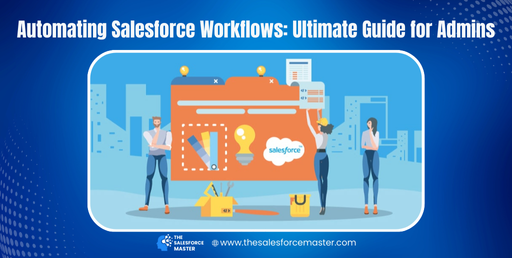
Automating Salesforce Workflows: Ultimate Guide for Admins
Salesforce workflows help streamline operations and improve efficiency for businesses. By automating repetitive tasks, administrators can focus on strategic initiatives. This guide explores how Salesforce admins can effectively automate workflows while maximizing productivity.
Key Benefits of Automating Salesforce Workflows
Automating workflows in Salesforce provides several advantages. From reducing manual effort to enhancing data accuracy, the benefits are transformative for organizations. Key advantages include:
- Improved Efficiency: Automation reduces time-consuming manual tasks, enabling teams to focus on high-value work.
- Enhanced Data Consistency: Automated processes ensure consistent data input, minimizing errors.
- Better Task Management: Workflow rules and process automation enable timely task assignments and follow-ups.
- Streamlined Operations: Businesses achieve streamlined operations by aligning workflows with Salesforce Login integrations and other tools.
Admins play a crucial role in identifying areas where automation can make the most significant impact.

Steps to Automate Workflows in Salesforce
To create efficient automated workflows, Salesforce admins should follow these steps:
- Analyze Current Processes: Start by evaluating the existing manual workflows. Identify repetitive tasks and processes that can benefit from automation.
- Leverage Salesforce Tools: Use tools like Flow Builder, Process Builder, and Apex triggers to design custom workflows.
- Incorporate Salesforce Login and External Integrations: Ensure seamless integration of Salesforce Login for secure authentication and connections with third-party applications.
- Test Automation Rules: Test your workflows in a sandbox environment to validate functionality before deployment.
- Monitor and Optimize: Regularly monitor automated processes to identify areas for optimization. Use dashboards and reports to track workflow performance.
Best Practices for Admins
To ensure successful workflow automation, Salesforce admins should adhere to the following best practices:
- Use Key Salesforce Marketer Features: Leverage advanced marketing automation features such as personalization, segmentation, and dynamic content.
- Simplify Complex Workflows: Break down complex processes into manageable steps to minimize errors and improve performance.
- Train Users: Provide training to end-users, ensuring they understand automated processes and their benefits.
- Implement Security Measures: Use Salesforce Login and other security tools to protect sensitive data and ensure compliance with organizational policies.
- Document Processes: Maintain detailed documentation of automated workflows for future reference and updates.
Conclusion
Automating Salesforce workflows enables businesses to save time, improve accuracy, and enhance overall productivity. By leveraging tools like Salesforce Login and key Salesforce Marketer functionalities, admins can drive substantial organisational improvements. Following the outlined steps and best practices ensures a seamless and effective workflow automation journey.



